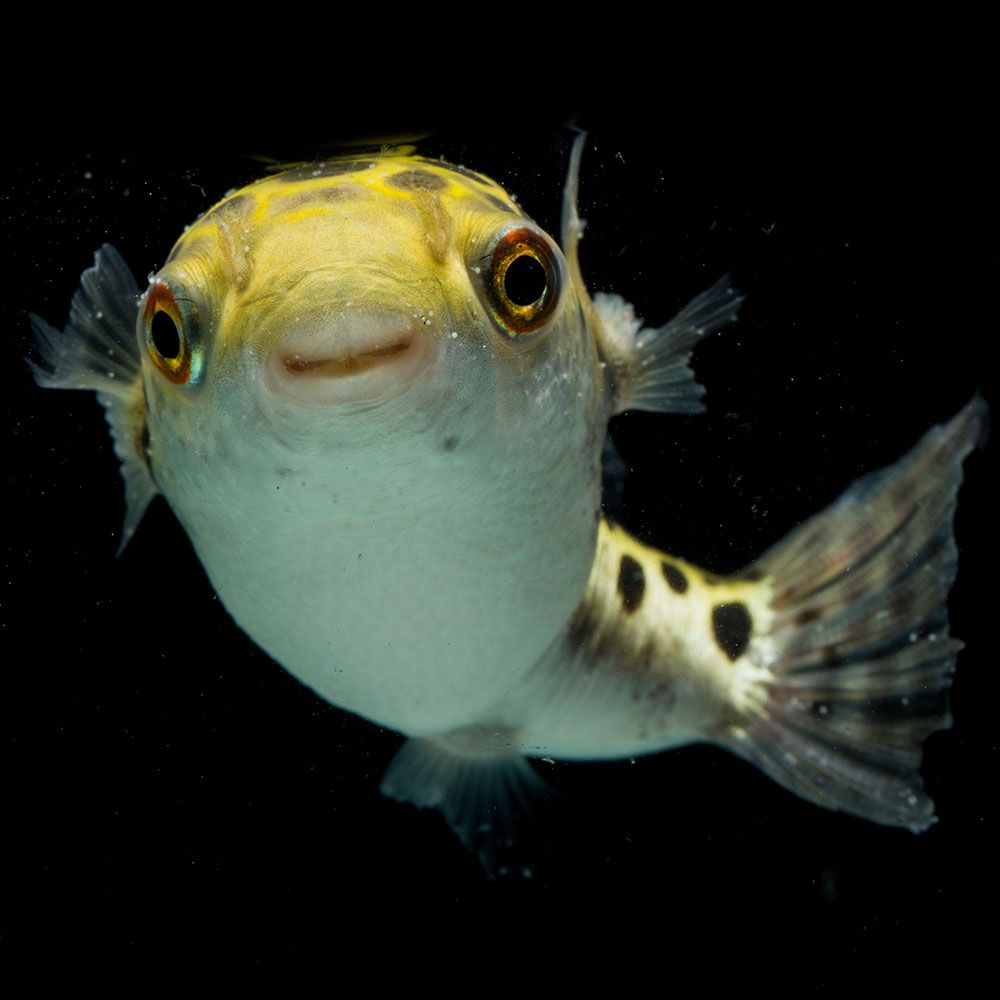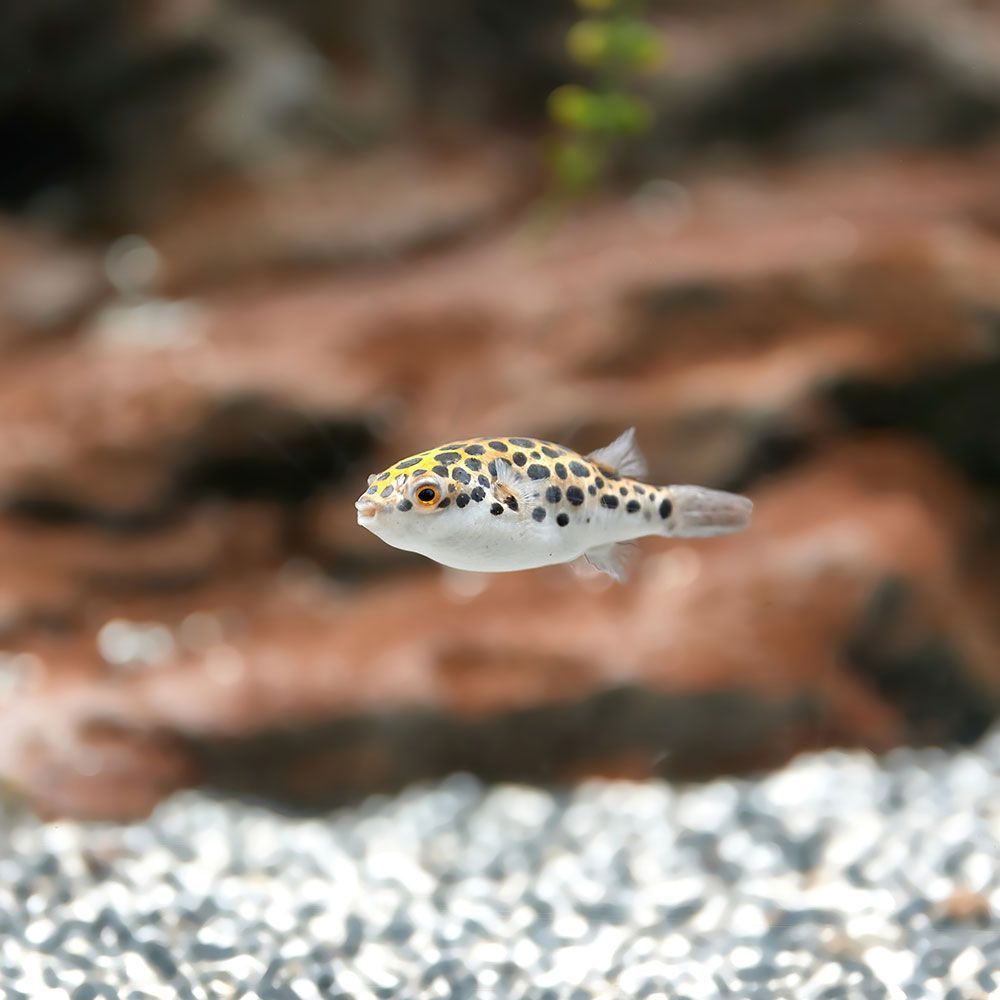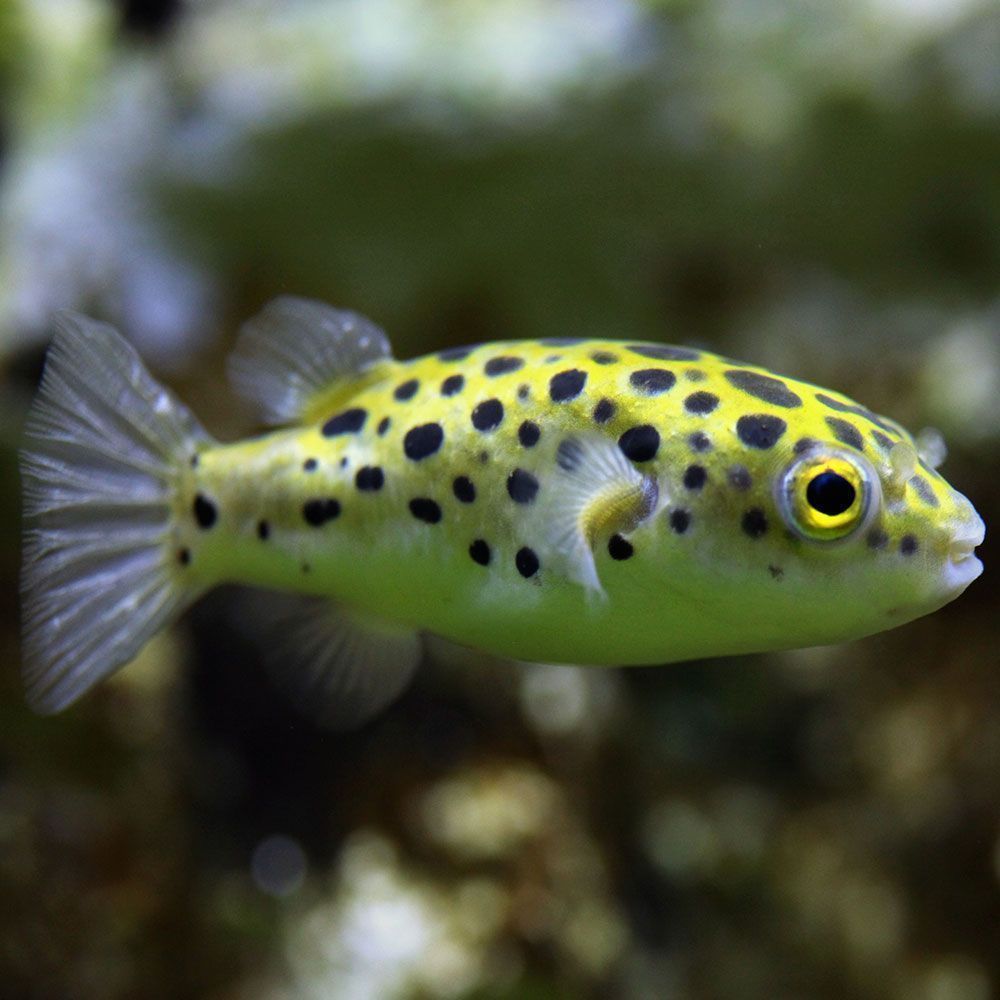Fun, interactive, and beautiful to look at, the stout green spotted puffers are one of our favorite brackish aquarium fish.
Known for their personality and never-ending appetite, these require a little more work than an average aquarium fish. But these vibrant, intelligent, and quickly bond with their keepers. It’s more than just cute fish if you’re ready to take that extra effort.
What is a Green Spotted Pufferfish?
The green spotted pufferfish is a brackish aquarium fish which is popular among the intermediate aquarium owners.
| Origin | Southeast Asia |
| Order | Tetraodontiformes |
| Family | Tetraodontidae |
| Scientific Name | Dichotomyctere nigroviridis |
| Common Names | Burmese pufferfish, leopard puffer, green pufferfish |
| IUCN Red List Status | Least Concern |
| Appearance | Round, stout body with a white underside and green-yellowish backside covered with black spots |
| Size | Up to 17 cm (6.8 in) |
| Lifespan | 10-15 years |
| Temperament | Curious, active, and aggressive |
| Tank Level | Middle dwellers, but they explore all levels of the aquarium |
| Water Temperature | 75 to 82 °F (24 – 28 °C) |
| pH Level | 7.5 to 8.2 |
| Water Hardness | 9 – 19 dGH |
| Care Level | Intermediate |
| Minimum Tank Size | 30 Gallons |
| Tank Environment | Spacious, heavily planted setup with lots of hiding spots |
| Diet | Carnivore |
| Tank Mates | Best kept solo or with other active species like scats, monos, and archerfish |
What is the Natural Habitat of Green Spotted Pufferfish?
Green spotted puffers are native to freshwater and brackish water habitats in East and Southeast Asia, spanning Sri Lanka to Indonesia and north to China. They can be found in rivers, mangrove swamps, and coastal areas.
When juvenile, they swim towards rain-flooded areas during the rainy seasons, preferring freshwater. But as they mature, they switch to brackish and marine water, making them versatile in handling different levels of saltiness (also called euryhaline species).
Since these are primarily found in tropical regions, they require warm and stable water temperatures to thrive. They are adaptable to various water depths and currents.
Which family does Green Spotted Pufferfish belong?
The scientific name for the green spotted puffer is Dichotomyctere nigroviridis. It belongs to the Tetraodontidae family and is classified under the order Tetraodontiformes.
The green spotted puffer has some interesting relatives within the same family, including the figure eight puffer (tetraodon biocellatus), spotted congo (tetraodon schoutedeni), and leiodon (tetraodon cutcutia).
These species share similarities in their body shape, behavior, and classification, but each has unique characteristics, making them intriguing family members.
They are assessed Least Concern by IUCN Red List.
Some common names of this fish are leopard puffer and Burmese puffer.
Fun Fact: Green spotted puffers have an insatiable appetite for snails! With their beak-like teeth, they chomp through shells effortlessly.
How does Green Spotted Pufferfish look?

The scattered black spots beautifully contrast against a GSP’s pale green-yellowish rounded body.
With a slightly elongated snout, big round bulging eyes, and a rounded body tapering at the tiny tail, these fish have a compact and visually appealing shape.
What is the Size of Green Spotted Pufferfish?
When you get green spotted puffers from stores, they’re generally 2-3 inches in size, and you can expect them to double to a maximum of 6-7 inches (15-17 cm) when mature.
What is the Color of Green Spotted Pufferfish?
As given away by the name, green spotted puffers have a vibrant greenish-yellow hue with irregular black spots all over their body.
Juveniles have a more intense and vivid green base, gradually fading to pale greenish-yellow as they mature.
What are the Features of Green Spotted Pufferfish?
This fish species is quite the eye-catcher, with its smooth skin covered in tiny scales and pectoral fins on the sides.
Unlike most fish, it lacks pelvic fins, but it compensates by using its pectoral fins for incredibly versatile and agile maneuverability.
How does male and female Green Spotted Pufferfish differ?
Identifying sexes in these green spotted puffers is nearly impossible by external features.
What is the Behavior & Temperament of Green Spotted Pufferfish?
These fish are highly inquisitive and intelligent but also aggressive at the same time.
These naturally tend to nibble on the fins of their tank mates, so it’s usually best to keep them solo in a tank or with just their kind.
But in my experience, if you keep these fish together with other mates from a young age, they show much less aggression. Just remember to give them plenty of room to swim around and lots of hiding spots to keep them happy and stress-free.
What is the Life Span of Green Spotted Pufferfish?
In captivity, these fish typically live for 10-15 years, but the lifespan also depends on genetics, diet, and environment.
Author’s Note: Green spotted puffers are clever and show real personality traits. It can recognize its owners and even learn cool tricks!
How to take care of Green Spotted Pufferfish?

Apart from providing them with proper water conditions, a balanced diet, and a suitable tank environment, you must also take care of a few more specifics.
What should be the Tank Size for Green Spotted Pufferfish?
For a single green spotted puffer, a minimum tank size of 30 gallons is recommended.
It’s best to keep only one fish per tank to avoid aggression issues unless you keep them together as juveniles.
When adding more fish, increase the tank size by at least 15 gallons per additional fish to ensure enough space for all of them.
What is the Water Chemistry for Green Spotted Pufferfish?
These fish thrive in brackish water, so aim to replicate this natural habitat in the aquarium.
- pH Level: 7.5 to 8.2.
- Water Temperature: 75 to 82 °F (24 – 28 °C)
- Water Hardness: 9 to 19 dGH
- Ammonia: 0 ppm
- Nitrite: 0 ppm
- Nitrate: Below 20 ppm
Regularly test the water quality and make necessary adjustments to maintain a healthy and comfortable tank for your fish.
What is the Tank Environment for Green Spotted Pufferfish?
The natural habitat of green spotted puffers has lots of lush greens, caves, and rocks. The plants and organisms naturally keep the water clean and balanced, creating a healthy environment for the fish.
But in an aquarium, without filters and adequate substrate, and plants, waste builds up quickly, leading to poor water quality, causing stress and health issues for the fish.
Which Substrate is needed for Green Spotted Pufferfish?
Go for a substrate on the softer side, like sand or smooth gravel. These curious fish love to dig and explore, and a softer substrate helps prevent any cuts and scrapes.
But many aquarists also suggest using aragonite or crushed coral as it keeps the pH stable and slightly alkaline, which is great for green spotted puffers.
These substrates contain calcium carbonate, a natural buffer that prevents pH fluctuations.
Which Plants are needed for Green Spotted Pufferfish?
Resilient plants like hornwort and java moss are ideal for these fish as they can handle a bit of chewing.
To create an engaging tank, use plants with twisted roots and branches, like anubias, offering ample hiding spots.
Leave some open spaces between the plants. This allows them to swim freely, matching their natural behavior.
What type of Lighting is required for Green Spotted Pufferfish?
Green spotted puffers are quite adaptable to lighting and don’t have specific requirements for lighting setups. A regular aquarium light will do the job just fine.
Aim for a photoperiod of around 10-12 hours of light per day to establish a natural day-night cycle.
Avoid using excessively bright lights that may promote algae growth or cause stress for the fish.
Which Décor is needed for Green Spotted Pufferfish?
These fish love exploring. So, keeping things interesting by regularly moving or replacing their tank decor is a good idea.
Create a naturally engaging environment with many plants, caverns, rockwork for retreats, and territorial boundaries that break up their line of sight.
What Filtration is required for Green Spotted Pufferfish?
Spotted puffers are messy eaters, and the tank needs to be cleaned often. So, install canister filters that pump at least 5-10 times the tank capacity every hour.
Freshen up the tank with about 30% water change every week. Add a tablespoon of aquarium salt per 20 liters to create a natural, lightly salty environment.
What is the Water Flow Rate for Green Spotted Pufferfish?
These fish enjoy a moderate water flow in their tank.
You can use an adjustable powerhead to recreate the watercourse in its natural habitat. This way, you can ensure their tank is adequately filtered and oxygenated without causing unnecessary stress to your fish.
Pro Tip: These fish are skilled jumpers, so use a fully enclosed lid to prevent escape.
What do Green Spotted Pufferfish eat?
GSPs enjoy feasting on small invertebrates, crustaceans, and snails.
You can also opt for bloodworms, brine shrimp, and small pieces of seafood like shrimp or squid and sometimes even commercial fish pellets or flakes. Follow a diet that ensures they receive a good balance of proteins and nutrients.
Treat them with live or frozen snails. It’s their favorite and tasty meal that provides nutrition and keeps their teeth strong.
Plus, watching them hunt and devour their prey is a fascinating sight!
What are the Tank Mates for Green Spotted Pufferfish?
When keeping tankmates, be mindful of their predatory behavior. Avoid slow-moving or long-finned fish, as they may become easy targets for fin-nipping. Some GSPs become more aggressive as they mature.
Instead, opt for more active mates like archerfish, scats, Arius catfish, and monos that can handle the brackish water environment and are less likely to provoke aggression.
If you plan to keep multiple of them together, starting with 3-4 juveniles is recommended. This can help disperse any aggressive behavior among them.
Which Tank Mates to Avoid for Green Spotted Pufferfish?
These puffers are best kept on their own. They’re territorial and belligerent towards their conspecifics, especially the males.
What are the Common Diseases in Green Spotted Pufferfish?
| Disease Name | Causes | Symptoms | Treatment |
|---|---|---|---|
| Ichthyophthiriasis | Parasitic infestations, poor water conditions | White spots on body and fins, flashing, lethargy | Medications with malachite green/formalin, raised water temperature |
| Fin Rot | Bacterial infection, poor water quality | Deterioration of fin tissue, frayed fins, loss of fin color | Antibacterial medications, improving water quality, salt baths |
| Swim Bladder Disorder | Genetics, overfeeding, poor diet | Difficulty swimming, floating upside-down, loss of balance | Adjusting diet, fasting, peas or daphnia to aid digestion |
How do Green Spotted Pufferfish breed?
Breeding these fish in an aquarium can be quite a challenge. You’ll need a separate breeding tank with specific water conditions and hiding spots.
What is the Male-to-Female Ratio for breeding Green Spotted Pufferfish?
It’s best to have a ratio of one male to two or three females. This helps reduce male aggression and provides better chances of successful breeding.
What is the Mating Ritual for Green Spotted Pufferfish?
Unlike some fish species, these fish don’t have a specific mating ritual.
The male guards a chosen spawning site, flat rock, or substrate, while the female deposits her eggs. The male fertilizes the eggs and continues to protect them until they hatch.
What are the Signs of Pregnancy for Green Spotted Pufferfish?
It can be challenging to tell if a female is carrying eggs, but you might notice her belly becoming rounder.
Their eggs are small, round, and translucent and may vary in size and color. They usually have an incubation period of around seven days.
How does the fry for Green Spotted Pufferfish Survive?
After hatching, the male typically moves GSP fry to a pre-excavated pit in the substrate for protection. Offering small live foods like Cyclops nauplii can support their growth and survival.
The male also takes some responsibility for guarding and protecting the fry.
Breeding Tip: Add plenty of hiding spots and lush greens in the breeding tank because these fish lay their eggs among plants and seek sheltered areas to protect their offspring. This will boost their chances of fry survival and help you breed like a pro!
How to buy Green Spotted Pufferfish?
Look for fish with lively behavior, bright colors, and no signs of illness.
Signs of good health:
- Clear eyes
- Intact fins
- Active
Signs of illness:
- Sluggish behavior
- White spots on the body
- Abnormal swimming patterns
Most stores typically keep these fish in fresh water, but their ideal habitat is brackish water.
When bringing them home, it’s crucial to gradually acclimate them to a saline water environment to prevent shock or potential harm.
A word from FishInAquarium
Green spotted puffers are vibrant, full of personality, and always keep things interesting. Although they need some extra attention, they make it worthwhile for home aquarists and community tanks.
Hope you enjoyed reading the guide as much as we enjoyed writing it for you! Please share it with your aquarist friends and happy fish keeping. Check out our other guides for valuable information on your favorite aquarium fish.


